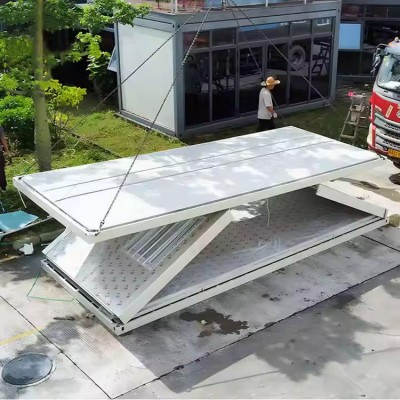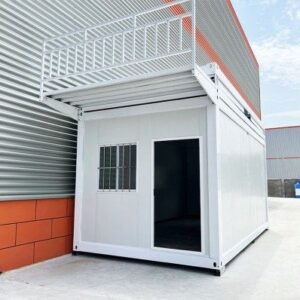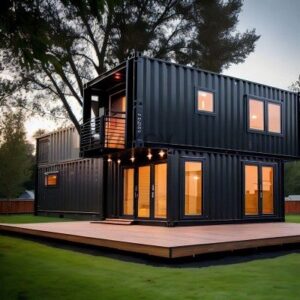If you’ve been wondering how much for a shipping container house and want a clear, honest answer, you’re in the right place. Shipping container homes are booming in popularity for their affordability and flexibility—but pinpointing the exact cost can be tricky. In this guide, I’ll break down the real price ranges, explain what drives costs up or down, and give you practical insights so you can confidently budget your container home project. Let’s cut through the noise and get straight to what you need to know!
Typical Cost Breakdown of a Shipping Container House with Price Ranges
When figuring out how much for shipping container house, it helps to break down the expenses into key parts. Here’s a clear look at what drives the overall price and typical cost ranges you can expect:
Shipping Container Cost
- $1,500 to $5,000 per container
The price depends largely on whether you buy new or used containers, container size (20ft or 40ft), and condition. New containers usually cost more but require less prep work.
Site Preparation and Permitting
- $3,000 to $10,000
Preparing your lot, leveling the ground, installing foundations, and getting necessary permits can vary widely based on your location and local regulations.
Customization and Construction
- $20,000 to $100,000+
This covers cutting for windows and doors, insulation, interior walls, plumbing, and electrical work. The more complex the design and finishes, the higher the cost, especially if you hire pros rather than DIY.
Utilities and Finishing
- $5,000 to $15,000
Hooking up water, sewage, electricity, and HVAC systems along with interior finishes such as flooring, cabinetry, and paint fall under this category.
Optional Add-ons
- $500 to $10,000
Extras like solar panels, decking, smart home tech, and landscaping all add to the final price, depending on your preferences and budget.
Examples of Cost by Container Home Size
- Small 20ft container home: Around $25,000 to $50,000
- Medium 2-container home: $50,000 to $90,000
- Large multi-container home: $100,000 and up
Each project will vary based on design, materials, and location, so these figures are solid starting points to set your budget.
What Is a Shipping Container House
A shipping container house is a type of home built by repurposing steel shipping containers into livable spaces. These containers are modular, sturdy boxes originally designed for cargo transport. By converting these containers, you get a cost-effective and eco-friendly housing option that’s gaining popularity for both residential and commercial uses.
Common Uses and Advantages
Shipping container homes serve as everything from tiny homes and guesthouses to full-sized family residences and vacation cabins. The major benefits include:
- Eco friendly: By recycling existing containers, you reduce waste and resource consumption.
- Modular and flexible: Containers can be combined or stacked for customized layouts.
- Cost effective: Typically, building with containers costs less than traditional construction.
- Durable and secure: Made from weather-resistant steel, they’re strong against harsh conditions.
Design and Customization Potential
One of the biggest draws of shipping container house construction is how adaptable the design can be. It allows for:
- Cutting openings for windows and doors
- Adding insulation for climate control
- Integrating plumbing, electrical, and HVAC systems
- Incorporating modern touches like solar panels, decking, and smart home technology
This flexibility means you can have a unique home that fits your style and budget, whether you want a simple container tiny house or an expansive multi-container residence.
For a deeper dive into container home building, check out this detailed guide on how to make a shipping container house.
Factors Influencing the Cost of a Shipping Container House
When figuring out how much for a shipping container house, several key factors come into play that can significantly impact your overall budget. Understanding these will help you plan better and avoid surprises.
Container Purchase Price New vs Used
The initial cost starts with the container itself. New containers usually cost between $3,000 to $5,000 each, while used ones are cheaper, often $1,500 to $3,000 depending on condition and size. New containers last longer and need fewer repairs, but used containers might save you money upfront if you’re okay with some wear and tear.
Size and Number of Containers Used
Bigger is naturally more expensive. A single 20ft container can work for a tiny home, while combining multiple containers creates larger living spaces. More containers mean more costs not only for purchase but also for setup, welding, and finishing.
Location Site Preparation and Permitting
Where you build matters. Land costs, soil quality, and site access affect how much you’ll pay to prep your foundation and turn the lot ready for construction. Plus, permits and zoning can add $3,000 to $10,000 depending on local regulations. Urban areas often charge more for permits and inspections than rural locations.
Customization and Design Complexity
The extent of interior and exterior work, such as insulation, windows, doors, plumbing, and electrical systems, strongly affects cost. High-end finishes, custom layouts, and energy-efficient upgrades increase expenses. Simple designs with basic amenities cost less but may limit comfort and resale value.
Labor and Construction Costs DIY vs Hiring Pros
Doing it yourself saves money but requires skills, time, and tools. Hiring professionals increases labor costs but ensures quality and faster completion. Labor can run anywhere from $20,000 to $70,000+, depending on complexity and region.
Transportation and Delivery Fees
Transporting the container to your site involves fees based on distance, size, and road access. Delivery can range from a few hundred to several thousand dollars, especially for hard-to-reach or restricted areas.
Utilities Hookup Costs Water Sewage Electricity
Connecting water, electricity, and sewage depends on how close your site is to existing utility lines. Costs vary widely but expect to pay $5,000 to $15,000 for hookups, including potential upgrades to your electrical system or adding septic tanks.
Additional Features Impact on Cost
Extras like decks, solar panels, smart home technology, and landscaping add convenience and appeal but come with extra price tags. Solar setups vary widely but plan for a few thousand dollars if energy efficiency is important.
Shipping Container House vs Traditional Home Costs
When comparing shipping container house costs to traditional homes, there are several important factors to weigh, from construction time to long-term expenses.
Construction Time and Initial Costs
Shipping container homes often cost less upfront and take less time to build than conventional houses. Because containers are modular and prefabricated, the basic structure is ready-made, cutting down framing and major construction work. This can shave months off the timeline, saving on labor costs.
On average:
- A traditional home can take 6 to 12 months to build with higher labor expenses.
- A container home can be completed in 3 to 6 months, especially if you opt for a kit or professional modular builder.
Affordability and Cost Breakdown
Container home construction costs are generally lower due to reduced material expenses and simplified foundations. For example, the cost of buying and modifying a container plus necessary customization often comes in well below traditional building materials and processes.
However, prices will vary based on:
- Size and number of containers.
- Level of customization.
- Site-specific requirements like land prep and permits.
Long Term Maintenance and Durability
Shipping container homes are made from steel, which means durability and resistance to pests and harsh weather, often translating to fewer maintenance costs over time compared to wood-frame homes.
But, be aware of potential downsides:
- Insulation and moisture control must be handled carefully to prevent rust and condensation.
- Modifications like windows and plumbing may require specialized labor, which could be more costly.
Trade Offs to Consider
- Space constraints: Containers have limited width, which may require creative design to feel spacious.
- Resale value: Container homes are trendy but not yet mainstream, which can affect resale or financing options.
- Customization costs: Adding features like solar panels, decks, or advanced tech can boost overall expenses.
of Key Differences
| Aspect | Shipping Container House | Traditional Home |
|---|---|---|
| Construction Time | 3-6 months | 6-12 months |
| Base Costs | Lower due to prefab structure | Higher materials and labor costs |
| Durability | Steel structure resists pests/weather | Wood/frame may require more upkeep |
| Space | Limited width per container | Flexible room sizes |
| Long-term Maintenance | Lower if properly insulated and sealed | Variable depending on materials |
In the U.S. market, a shipping container home can offer an affordable, quick alternative with durable benefits, but you should factor in design limits and potential additional customization costs when comparing budgets.
How to Get the Best Value for Your Shipping Container House Investment
Getting the most out of your shipping container house investment means careful budgeting, picking the right suppliers, and smart construction choices. Here are some key tips to help you manage costs and end up with a quality, affordable home.
Budgeting and Planning Your Container Home
- Start with a clear budget that includes containers, site prep, permits, construction, and utilities.
- Factor in unexpected expenses like upgrades or delivery delays.
- Use a shipping container house cost calculator or get quotes from multiple builders to compare prices.
- Prioritize what features matter most to you — focusing on essentials first helps avoid overspending.
Choose Reputable Container Suppliers Including Yichen
- Look for suppliers known for quality containers and transparent pricing.
- Yichen is an example of a reputable supplier offering both new and used containers suitable for homes.
- Ensure the supplier provides certifications or inspections to avoid costly repairs later.
- Ask about delivery options and whether they include transport fees in the price to avoid surprises.
DIY versus Professional Builders
- DIY container home construction can save you a lot but requires skills in welding, insulation, and electrical work.
- Professionals bring experience and proper permits, speeding up the build and ensuring code compliance.
- Consider a hybrid approach: handle non-technical tasks yourself to save money but hire pros for complex work.
- Remember, cutting corners on labor can lead to higher maintenance costs over time.
Proper Insulation and Design for Energy Savings
- Insulation is critical to keep your container house comfortable year-round and reduce utility bills.
- Options like spray foam, blanket insulation, or insulated panels vary in cost and effectiveness.
- Smart design—such as positioning for natural light and ventilation—also helps lower energy use.
- Invest in energy-efficient windows, doors, and HVAC systems to save money long term.
By focusing on these areas, you can keep your shipping container home budget in check while building a durable, comfortable, and efficient living space.
Regional Cost Variations for Shipping Container House Pricing
When it comes to the cost of building a container home, location plays a huge role. Shipping container house prices, permits, and construction costs can vary a lot depending on where you plan to build.
How Location Affects Shipping Container House Costs
- Shipping and Delivery FeesTransporting containers to your site can be pricey, especially if you’re in a remote or rural area. Urban areas near ports tend to have lower delivery fees, while coastal or mountain locations may add extra because of access challenges.
- Permitting and Zoning RulesEvery state and city has different rules on permits for container homes. Some places are container-friendly with straightforward codes, while others require more red tape or even deny approvals—this can increase your overall budget.
- Construction Pricing DifferencesLabor costs differ regionally. In big cities, professional construction teams charge more compared to rural areas. This affects installation, customization, and utility hookups, which are key parts of your container home construction cost.
Example Regional Cost Estimates
| Region | Estimated Cost Impact | Notes |
|---|---|---|
| Urban Areas | Moderate to High shipping container house prices | Higher labor and permit costs; better access to materials and skilled labor |
| Rural Areas | Lower construction costs but higher shipping fees | Easier permits in some cases; limited access to specialized trades may add time |
| Coastal Areas | Higher overall cost due to permits and weather-proofing | Coastal codes may require reinforcement; shipping may be easier if near port |
These regional factors can easily add thousands to your budget so factoring these in early can help you avoid surprises. Always check local regulations and get quotes for container delivery before committing.
Understanding local considerations is essential to accurately estimate your shipping container house installation costs and overall investment.

Frequently Asked Questions About Shipping Container House Costs and Financing
Can I Finance a Shipping Container Home
Yes, financing a shipping container home is possible but can be more challenging than traditional homes. Conventional mortgages often don’t cover container homes unless they’re permanently installed on a foundation and meet local building codes. Some options include:
- Personal loans or construction loans specifically for alternative housing.
- Specialized lenders that finance modular or prefab homes.
- Home equity loans if you own property already.
- Using DIY financing like savings or crowdfunding.
Be prepared to provide detailed plans and permits to lenders, as shipping container house financing is less common than traditional home loans.
How Long Does Construction Take for a Shipping Container Home
The construction timeline varies depending on the home’s size, design complexity, and whether you build it yourself or hire professionals. Typical ranges are:
- Small or basic container homes: 2 to 4 months.
- Medium sized homes with customization: 4 to 8 months.
- Large or complex projects: 8 months to over a year.
Factors like site preparation, permitting delays, and sourcing materials can also affect the timeframe.
Are There Restrictions or Permits Required for Shipping Container Houses
Yes, permits and zoning approval are usually required before building a shipping container home. These include:
- Building permits based on local codes.
- Zoning clearance to ensure container homes are allowed in your area.
- Electrical, plumbing, and HVAC permits as needed.
- Compliance with energy and safety codes.
Regulations vary greatly by city and county. Some areas are friendly to container homes, while others may have restrictions or require extensive paperwork.
What About Durability and Resale Value of Shipping Container Homes
- Durability: Shipping containers are made of strong steel, designed to withstand harsh conditions, so the core structure is quite durable. Proper insulation and maintenance are important to prevent rust and condensation issues.
- Resale Value: Resale can be tricky. While container homes appeal to niche buyers looking for affordable, eco-friendly options, they are less common than traditional homes, potentially limiting your market. Resale value depends on build quality, location, and how well the home integrates with local housing markets.
Maintaining professional design and quality build standards can help maximize both lifespan and resale appeal.



